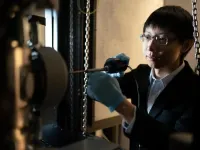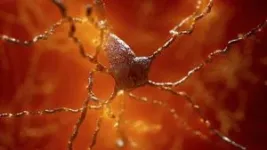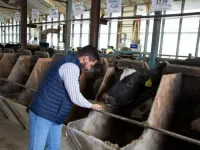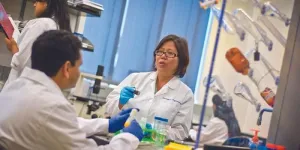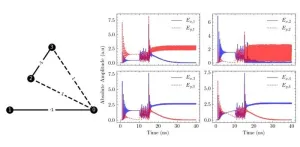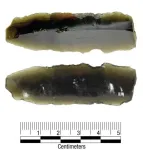(Press-News.org) UNIVERSITY PARK, Pa. — A new class of metallic materials with potential applications in airplane turbines, nuclear reactors and equipment for space exploration can withstand extreme temperatures and resist fractures, but scientists haven’t understood why until now. According to a new study co-led by Penn State researchers, the answer could relate to the material’s short-range order, or the local arrangement of atoms within a material. This knowledge could lead to further improvement in the mechanical performance and damage tolerance of these materials, the researchers said, leading in turn to advancements in the safety and reliability of next-generation engineering systems for transportation or power plants.
Their results were published in Nature Communications.
The team developed a new imaging method to study the local atomic arrangement of the metallic materials, called high- and medium-entropy alloys (HEA/MEA), and focused their study specifically on the chromium-cobalt-nickel (CrCoNi) MEA and its impacts on mechanical performance.
“The mechanical performance of the CrCoNi is amazing,” said co-corresponding author Yang Yang, Penn State assistant professor of engineering science and mechanics and nuclear engineering who is also affiliated with the Materials Research Institute. “For example, it has recently been shown to have the highest toughness on earth at nearly -423 degrees Fahrenheit. But people didn’t know why it was so good.”
Some scientists, Yang said, hypothesized that short-range order was responsible for this.
“But because the short-range order is so small and subtle in materials, it’s very challenging to observe or measure it in order to provide experimental proof,” said co-corresponding author Andrew M. Minor, professor of materials science and engineering at the University of California Berkeley (UC Berkeley) and Lawrence Berkeley National Laboratory (LBNL).
CrCoNi has three components: chromium, cobalt and nickel. Each element has the same atomic fraction within the alloy, and early studies assumed that each of the three kinds of atoms was randomly distributed within the system, according to Yang. However, Yang said that recent studies show the material actually displays short-range order.
“Let’s imagine that there’s a party with people from Penn State, Ohio State and North Carolina State,” Yang said. “And, ideally, you’d expect everyone to mingle seamlessly, creating a uniform mix of individuals throughout the room. However, in practice, this isn't always the case. Often, people from the same university tend to gravitate towards each other, drawn by shared experiences. This is a kind of short-range order, deviating from the anticipated random distribution.”
In order to study the role of short-range order in CrCoNi, the team designed an experiment using an energy-filtered 4D scanning transmission electron microscopy (4D-STEM) system. In a 4D-STEM experiment, a nanosized electron beam scans on the sample, generating a nanobeam electron diffraction pattern for each point. According to Minor, they were able to capture hundreds of electron diffraction images every second, allowing them to analyze the evolution of material defects under stress with both a large field of view and high resolution.
“Defects are formed during the mechanical deformation process, and we actually found that there's a transition in the formation of a defect,” Minor said, noting that they focused specifically on planar defects, or the “errors” in the stacking sequence of planes of atoms. “We found that the planar defect is fully reversible during the initial cycles. If we deform it and then release the force, it fully recovers. However, after around a thousand cycle of mechanical deformation, this reversibility disappears. At that point the defect tends to stay there after we release the load. And this transition, we think, is actually governed by the short-range order in this system.”
Yang said this is because at the beginning, the system has a lot of short-range order that makes the reversible processes favorable. However, the deformation gradually destroys this small ordering, and that tunes the deformation mechanism towards another one that favors this formation of a planar defect.
“The short-range order is like a moderator,” Yang said. “The local density of it, or the degree of it, controls which mechanism is working, which is not working. The synergy of varied deformation mechanisms is critical for the high damage tolerance in this material class.”
By successfully providing a technique to visualize planar defect evolution in CrCoNi and integrating advanced atomistic modeling, the researchers were able to reveal the interaction between short-range order and planar defects, which could enhance these alloys’ mechanical performance.
The other authors on the paper are Yingxin Zhu, a graduate student in the Department of Engineering Science and Mechanics and the Material Research Institute, both at Penn State; Sheng Yin, Qin Yu and Colin Ophus of the LBNL; Jun Ding of the State Key Laboratory for Mechanical Behavior of Materials, Xi’an Jiaotong University Xi’an, China; Ruopeng Zhang of the Department of Material Science and Engineering at UC Berkeley; and Mark Asta, and Robert O. Ritchie of the Department of Materials Science and Engineering at UC Berkeley and of the LBNL.
The U.S. Department of Energy primarily supported this work.
END
New structural insights could lead to mechanical enhancement in alloys
2024-02-23
ELSE PRESS RELEASES FROM THIS DATE:
New research challenges conventional picture of Parkinson's disease
2024-02-23
Parkinson's disease, the second most common type of progressive dementia after Alzheimer's disease, affects nearly 1 million people in the U.S. and an estimated 10 million individuals worldwide. Each year, close to 90,000 new cases of Parkinson’s disease are diagnosed in the U.S.
In a new study, Jeffrey Kordower, director of the ASU-Banner Neurodegenerative Disease Research Center, and his colleagues unveil pivotal insights into the progression of Parkinson's disease, presenting new hope for patients battling the severely debilitating disorder.
The research highlights the role of a critical protein called tau in the early stages of the ...
Dairy cows fed botanicals-supplemented diets use energy more efficiently
2024-02-23
UNIVERSITY PARK, Pa. — Supplementing the feed of high-producing dairy cows with the botanical extract capsicum oleoresin, obtained from chili peppers, or a combination of that extract and clove oil resulted in the animals using feed energy more efficiently and emitting less methane from their largest stomach, according to a new study conducted by Penn State researchers.
Adding those substances, sometimes referred to as essential oils, to the cattle’s rations resulted in improved efficiency of energy utilization in peak-lactation dairy cows. According to Alex Hristov, distinguished professor of dairy nutrition, ...
Aston University receives nearly half a million pounds to create safer and greener batteries
2024-02-23
• Researchers to explore the use of gel electrolyte materials to improve lithium-ion batteries
• The batteries are the most commonly used in electric vehicles and electronics
• Will use non-harmful, non-flammable and renewably sourced materials for next generation battery technologies.
Aston University researchers are to explore the use of gel electrolyte materials to make lithium-ion batteries - the most commonly used for electric vehicles and electronics - safer and less environmentally damaging.
The University has received a grant of £443,058 from the Engineering and Physical Sciences Research ...
New study shows glycan sugar coating of IgG immunoglobulin can predict cardiovascular health
2024-02-23
When people hear about predicting heart disease, most will think of cholesterol levels. While cholesterol is a major contributor to heart disease, a recent study from Brigham and Women's Hospital, a founding member of Mass General Brigham, found that a glycan biomarker of IgG is also an important predictor for cardiovascular diseases (CVD). The researchers studied the sugar coatings on an antibody known as immunoglobulin G (IgG), which is implicated in the immune responses associated with chronic inflammation among participants in two case-control studies. The results of this investigation provide another biomarker for identifying risk of CVD, which could lead to earlier diagnosis ...
Sir Peter Rigby appointed as honorary chair of Aston University’s new Digital Futures Institute
2024-02-23
Sir Peter was knighted for his contribution to IT and businesses in the Midlands in 2002
He will provide guidance, support, advocacy and strong links to industry in his role
The Institute will drive digital innovation and ensure digital inclusion.
Aston University is delighted to announce that it has appointed one of the UK’s most respected and successful business leaders, Sir Peter Rigby, as honorary chair of its new Digital Futures Institute.
The announcement of Sir Peter’s appointment was made in front of guests at the inaugural lecture given by Professor Abdul Sadka, director of the Digital ...
Yale School of Medicine receives a $575,000 grant from PolyBio Research Foundation to fund long COVID research
2024-02-23
Yale School of Medicine and its Center for Infection & Immunity (CII) are receiving a $575,000 grant from PolyBio Research Foundation to fund Long COVID research. The grant—issued via PolyBio’s LongCovid Research Consortium (LCRC)— will support a collaboration to define mechanisms by which the SARS-CoV-2 virus can persist for long periods of time in tissue and blood.
There is growing evidence that SARS-CoV-2 may not fully clear from Long COVID patients after initial infection. Instead, reservoirs of the virus can persist in patient tissue for months or even years, with recent research finding the SARS-CoV-2 ...
Common plant could help reduce food insecurity, researchers find
2024-02-23
UNIVERSITY PARK, Pa. — An often-overlooked water plant that can double its biomass in two days, capture nitrogen from the air — making it a valuable green fertilizer — and be fed to poultry and livestock could serve as life-saving food for humans in the event of a catastrophe or disaster, a new study led by Penn State researchers suggests.
Native to the eastern U.S., the plant, azolla caroliniana Willd — commonly known as Carolina azolla — also could ease food insecurity in the near future, according to findings ...
Innovative chemotherapy approach shows promise against lung cancer
2024-02-23
Lung cancer is not the most common form of cancer, but it is by far the deadliest.
Despite treatments such as surgery, radiation therapy and chemotherapy, only about a quarter of all people with the disease will live more than five years after diagnosis, and lung cancer kills more than 1.8 million people worldwide each year, according to the World Health Organization.
To improve the odds for patients with lung cancer, researchers from The University of Texas at Arlington and UT Southwestern Medical Center have pioneered a novel approach to deliver cancer-killing drugs directly into cancer cells.
“Our method ...
Encoding computers of the future
2024-02-23
In our data-driven era, solving complex problems efficiently is crucial. However, traditional computers often struggle with this task when dealing with a large number of interacting variables, leading to inefficiencies such as the von Neumann bottleneck. A new type of collective state computing has emerged to address this issue by mapping these optimization problems onto something called the Ising problem in magnetism.
Here's how it works: Imagine representing a problem as a graph, where nodes are connected by edges. Each node has two states, either +1 ...
Artifact could be linked to Spanish explorer Coronado's expedition across Texas Panhandle
2024-02-23
DALLAS (SMU) – It’s a small piece of obsidian, just over 5 centimeters long, likely found on a hard-scrabble piece of ranchland in the Texas panhandle. But when SMU anthropologist Matthew Boulanger looks at it, he gets a mental image of Spanish explorer Francisco Vasquez de Coronado making his way across the plains more than 470 years ago in search of a fabled city of gold.
Boulanger believes that the flaked-stone tool with its sharp edge was likely dropped by a member of Coronado’s ...
